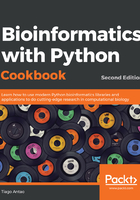
上QQ阅读APP看书,第一时间看更新
There's more...
P. falciparum is a reasonable example of a eukaryote with a small genome that allows you to perform a small data exercise with enough features, while still being useful for most eukaryotes. Of course, there are no sex chromosomes (such as X/Y in humans), but these should be easy to process because reference genomes do not deal with ploidy issues.
P. falciparum does have a mitochondrion, but we will not deal with it here due to space constraints. Biopython does have the functionality to print circular genomes, which you can also use with bacteria. With regards to bacteria and viruses, these genomes are much easier to process because their size is very small.